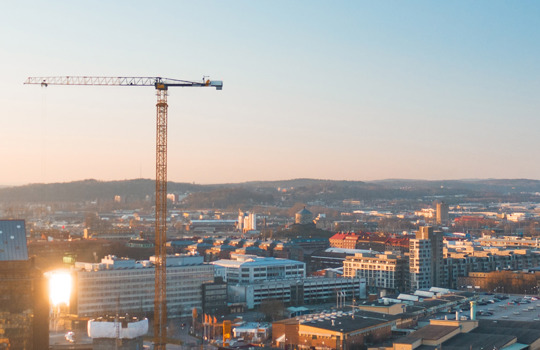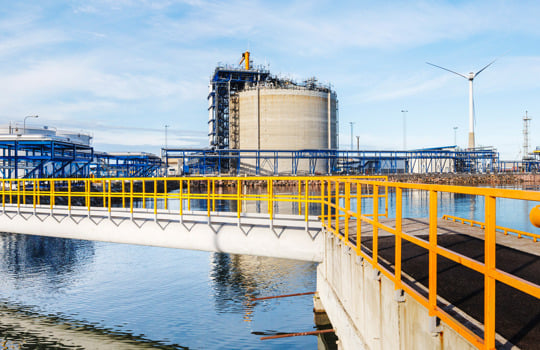Fuel’s life cycle emissions matter – Biogas cuts emissions through its value chain
Biogas is a 100% renewable fuel that can even turn the fuel’s life cycle emissions negative. Gasum’s biogas plants are operated under the principles of circular economy. In addition to biogas, the plants produce recycled nutrients and fertilizers that can replace fertilizers from fossil or mineral origin and eventually return the nutrients of biogas’ source materials to agriculture use.
Biogas is a completely renewable fuel that can reduce fuel’s life cycle emissions up to 90 percent when compared to traditional fuels such as diesel. Life cycle emissions take into account all greenhouse gas emission generated during the lifecycle of the fuel, including raw materials, production, distribution and the use of fuel. It is important to consider the entire lifecycle when analyzing fuels’ sustainability. For example, even if electric cars produce zero emissions per se, the electricity they use must be generated somehow. This can actually increase the electricity’s life cycle emissions.
Gasum, as one of the biggest biogas producers in the Nordics, has developed a consistent well-to-wheel supply chain for biogas. It allows the tracking of each delivered batch of biogas right to its source.
“We systematically follow the sustainability of our biogas. This means that we know exactly the raw materials from which biogas is produced, and what is the carbon footprint of each batch. All biogas we deliver to customers fulfills the sustainability criteria set by the EU Renewable Directive. On top of that, our biogas is the only Finnish fuel for vehicles that has been awarded the Nordic Swan Ecolabel,” says Elina Saarivuori, Sustainability Manager from Gasum.
Biogas is methane produced from organic waste
Biogas production follows the principles of circular economy. It is produced from organic waste, such as household biowaste, side streams of food industry, sewage sludge, and manure.
After pretreatment, the biomass is diluted with water and pumped into a biogas reactor. Before it can be digested, the biomass has to be hygienized, which means that all the unwanted bacteria like bacterium coli will be exterminated. The digestion itself takes place in a large anaerobic tank, a biogas reactor.
“The digestion process takes between three weeks to three months. The time frame depends on what the biomass consists of. If the mass is harder for the bacteria to process, it will decompose slower,” tells Ari Suomilammi, Production Director from Gasum.
The gas produced in the reactors is 60–70% methane and 30–40% carbon dioxide. Usually, it is refined into a final product that is 97% methane i.e., biomethane, as we know it. Depending on its usage the gas will then be either compressed for passenger cars, garbage and delivery trucks, and buses, or liquefied for heavy-duty transport operating line haul routes, maritime traffic and the use of different industries.
Biogas production produces recycled nutrients and fertilizers
The digestate from biogas production is also utilized. The digestate contains a lot of nutrients, such as phosphorus, nitrogen, and potassium, which are valuable in nutrients and fertilizers used in agriculture. The solid mass separated from the digestate can also be used as raw material for soil or growing matter production. When processed even further, parts of the digestate can be turned, for example, into ammonia water that’s used in industry.
“Recycling the nutrients from the organic waste mass back to nourish the soil, is at the core of circular economy. This enables us to use the nutrients again rather than produce them from fossil or mineral origins,” tells Ari Suomilammi.
For example, Gasum’s nitrogen water, utilizing recycled nitrogen, has a 90 percent smaller carbon footprint than technical urea produced industrially. And the amount of nutrients produced isn’t insignificant either. Gasum’s biogas plants recycle enough phosphor per year to suffice 25 percent of the yearly phosphor usage in Finland.
What do negative emissions mean?
The total life cycle emissions of biogas depend on the feedstock among other things. When biogas is produced from manure, the greenhouse gas emissions generated in the traditional manure treatment are avoided, and thus the total life cycle emissions of biogas can even be negative. It means that more greenhouse gas emissions are avoided by treating manure at a biogas plant, than are generated in the production, distribution, and use of biogas.
“Normally manure, when stored at a farm and spread on the fields, would release methane into the atmosphere. When it’s processed in a biogas plant, it is digested into biogas, collected, and eventually used as a fuel in transportation, for example. As methane is a 25 to 30 times stronger greenhouse gas when compared to carbon dioxide, this really makes a difference,” explains Elina Saarivuori.
A bucketful of biowaste equals a half-marathon
Because biogas is produced from organic waste, its production potential is significant. Gasum’s experts have calculated that with a bucketful of household biowaste a passenger car can drive the length of a half-marathon.
“At the moment, Gasum processes just under one million tons of organic biomass per year. This means a daily amount of up to 68 truckloads of waste. It is enough for an annual fuel consumption of 80 000 passenger cars or almost 4 000 heavy-duty vehicles,” tells Suomilammi.
According to Gaia Consulting the potential of biogas production, when included also synthetic methane, is up to 24 TWh in Finland, 35 TWh in Sweden and 13 TWh in Norway.
“And the Nordic countries are not the only ones wanting to promote the production and use of biogas. Biogas is also trending in central Europe, for example in France, Germany, and the Benelux-area,” says Suomilammi.

Join the cycle
Anyone can join the biogas cycle; municipalities, big industries and even your private household, and help shift the world from a linear to a circular economy, reducing CO2-emissions and helping to reach sustainability goals.



